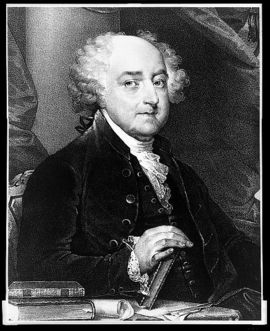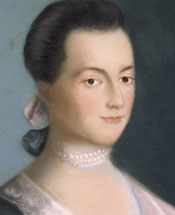John Adams
John Adams (1735-1826) was an American Founding Father, diplomat, and the second President of the United States from 1797-1801. Adams was a prominent figure of the American Revolution. His numerous accomplishments include involvement in the drafting of the Declaration of Independence, writing the constitution for the state of Massachusetts, serving as a diplomat to England, France, and The Netherlands, negotiating the Treaty of Paris, and serving as the first Vice President of the United States under President George Washington.
In the presidential election of 1796, Adams, on the ticket of the Federalist Party, defeated the Democratic-Republican nominee Thomas Jefferson and became the second President of the United States. He served only one term, losing to Jefferson in a bitter rematch known as the Revolution of 1800. His presidency was marked by the Quasi-War between the United States and France, the XYZ Affair, the founding of the U.S. Navy, the passage of Aliens and Sedition Acts, peace with France, and the appointment of John Marshall as Chief Justice.
He was the head of the Massachusetts based Adams political family. Members of the family include his cousin and fellow revolutionary Samuel Adams and his son John Quincy Adams, the sixth U.S. President.
Early Life
John Adams was born in the small community of Braintree, in the Massachusetts Bay Colony, on October 19, 1735. His father was a farmer, shoemaker, and church deacon, which led to the modest upbringing that would define Adams' life. At a young age Adams developed a love of books and studying, and at the age of 15 he was admitted to Harvard College and graduated in 1755. Deciding to pursue a career in law, he first took a job as a schoolmaster in Worcester to save money for an apprenticeship. He was admitted to the bar in 1759. Upon his father's death in 1761, Adams inherited the family farm and became a freeholder. He established his first law office out of his house. He married Abigail Smith Adams in 1764 and would have four children with her. He was influenced by the revolutionary lawyer James Otis, from whom he adopted some of his revolutionary thoughts, but he focused mainly on local politics until the passage of the Stamp Act of 1765, which he opposed vigorously.[1]
Political Career
American Revolution
Adams was a vocal critic of the Stamp Act, a tax passed by the British Parliament in 1765, and supported the Sons of Liberty[2], a rebellious organization attacking symbols of British control. He participated in the Massachusetts General Court's response to the Act. Following the Boston Massacre of 1770, in which British troops opened fire on a crowd, Adams defended the accused in court and six of them were acquitted as result.[3] He served a delegate in both the First and the Second Continental Congresses. He signed the Declaration of Independence, as well as playing a small roll in the drafting process. Thomas Jefferson later remarked that Adams was the Declaration of Independence's "pillar of support on the floor of Congress, its ablest advocate and defender."[1] Though Adams in principle opposed the practice of slavery, he remained silent when Jefferson was pressured to strike out a provision in the Declaration that condemned slavery.[4]
Adams served in Europe as a diplomat for the greater part of the war, serving in France and Holland. Adams was able to secure important loans from the Dutch, as well as collaborating with Benjamin Franklin and John Jay to negotiate the Treaty of Paris, ending the war with England. He would also serve as America's first foreign minister to England.
Vice President
The role of Vice President was one that Adams didn't settle into easily. His primary job was to serve as President of the Senate, in which his only duty was to cast tie-breaking votes. His relationship with the president was friendly, but Washington rarely asked him for his counsel. All of this was frustrating to Adams, who was a man of action and not shy about letting his opinions be known.[1] Adams once complained to his wife, "My country has in its wisdom contrived for me the most insignificant office that ever the invention of man contrived or his imagination conceived".[5] However, during his term Adams casted 29 tie-breaking votes, a record that still stands today, including voting to prevent another war with Great Britain.
Presidency
The Adams administration was not a tranquil one. The French were openly seizing American ships, leading to an undeclared war known as the Quasi-War. Adams sent diplomats to meet with the French Directory, only to be refused an audience and commercial relations were suspended. In 1798, the French demanded American diplomats to pay huge bribes in order to see the French Foreign Minister Talleyrand, which the diplomats rejected. This incident was known as the XYZ affair, after coded messages were sent from the diplomats refering to their French contacts as X, Y, and Z. Nationalist sentiment soon became overwhelming in the United States, causing the Congress to authorize Adams' plan to organize the navy.[5] Adams also reluctantly signed the Alien and Sedition Act as a wartime measure.
In 1799, however, his friendly response to French peace overture angered hardline Federalists such as Alexander Hamilton, leading to an intraparty chasm. Hamilton attacked Adams for his "ungovernable indiscretion" and "distempered jealousy".[1] This, plus the unpopularity of the Aliens and Sedition Act, led to Adams' electoral defeat to Jefferson in the 1800 presidential election.
Supreme Court appointments
John Adams appointed three justices to the Supreme Court. They are Bushrod Washington, who was George Washington's nephew, Alfred Moore, and Chief Justice John Marshall, who was instrumental in initiating the process of judicial review.
Later life and legacy
Adams largely retired from politics after stepping down from the White House. In 1820, however, he served as a delegate to the constitutional convention of Massachusetts. He resided in Quincy, Massachusetts in his later life and died there on July 4, 1826.
The naval ship USS John Adams SSBN620 was named after John Adams.
References
Notes and citations
- ↑ 1.0 1.1 1.2 1.3 U.S. Senate Art and History biography
- ↑ There are conflicting accounts on whether Adams formally joined the Sons of Liberty.
- ↑ Boston Massacre - 1770
- ↑ Hromatko, Wesley. John Adams. Unitarian Universalist Historical Society.
- ↑ 5.0 5.1 White House biography

